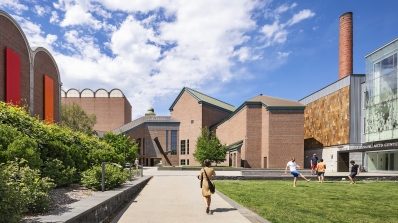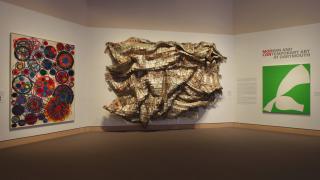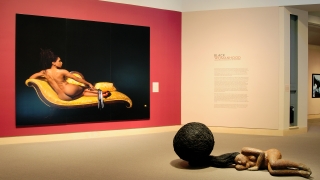Past Exhibitions
Constructing Black Identities across the African Diaspora
Made in the MiddleCultural anthropology began as the study of people—primarily in Africa—whom Europeans had defined as exotic, primitive, and uncivilized, but many later ethnographic studies debunked this colonial mindset. Today’s anthropologists aim to reveal the social, historical, and political construction of racial identities. The works of art in this small exhibition further this effort. They represent a host of colonial binaries—culture and civilization, traditional and modern, savage and civilized, rest and west, black and white—that often serve to perpetuate systems of inequality rather than understanding of our shared humanity. Taken together, the artists here reveal the difficult positions in which people of color find themselves when trying to simultaneously conform to standards upheld by white western society and recuperate a relationship to Africa or blackness. Yet the images expose not only the potential hurt but also the excitement of crafting hybrid identities from various cultures.
Chelsey Kivland, Robert A. and Catherine L. McKennan Postdoctoral Fellow of Anthropology, and Amelia Kahl, Hood Museum of Art Coordinator of Academic Programming, selected these works for Professor Kivland’s Introduction to Cultural Anthropology class. Students in the class wrote descriptive labels for these works and used them for a visual anthropology assignment.
Highlights from the African Art Collection at the Hood Museum of Art
Evolving PerspectivesMuseum collections usually form in one of two ways—either by gifts or through curatorial purchases. At a college or university museum, however, faculty members can also influence purchases of works of art and material culture that reflect their research and teaching interests.
This installation of African art from the Hood Museum of Art presents a selection of objects that marks the trajectory of the collection's development and pays tribute to some of the people who shaped it. From the son of an early Dartmouth president to a professor in Dartmouth's anthropology department; from donors whose love of African art is reflected in the quality of the works they gifted to three curators who acquired memorable and important works during their tenures—all have contributed the Hood's mission to teach Dartmouth undergraduates and visitors of all ages about the diverse and rich art of the many cultures of this continent.
Selections from the Hood Museum of Art
The Beauty of BronzeBronze—a combination of copper, tin, and small amounts of other metals—has long been prized for its preciousness, endurance, and ability to register fine details and reflect light. It is strong and durable, making it ideal for modeling expressive gestures, yet—in molten form—it is malleable enough to be suitable for creating intricate shapes. The term “bronze” is often used for other metals as well, including brass, which is an alloy of copper and zinc.
There are two basic methods of casting a bronze in order to make multiple versions of the same design. Sand casting—developed in the early nineteenth century in Europe—is a relatively simple and less expensive technique that relies upon disparate molds made of compacted fine-grained sand that allow for easy production and assembly. Traditional lost-wax casting uses wax models in two manners, or methods, both of which date from antiquity. In the “direct” method, the original wax model itself is used (and thereby destroyed); in the “indirect” method, reusable plaster molds are taken from the original wax model.
The medium’s intrinsic tensile strength and ability to render precise features and various surfaces have been applied to a variety of objects, including vessels, implements, portraits, animals, and figurines. The examples on display here document the worldwide attraction to this remarkable material from antiquity to the early twentieth century.
Exploring Figural Art from Africa
Art That Lives?
People around the world have at times responded to works of art as more than mere inanimate objects, seeing them instead as living things. This exhibition examines the complex ways that African peoples view images, especially depictions of the human form, as forces that impact personal experience. Sculptures from across the African continent reveal how art has mediated disputes, exerted political authority, and given presence to the dead.
Highlights from the Hood Museum of Art
Modern and Contemporary Art at Dartmouth
The third in a series of comprehensive exhibitions and catalogues showcasing the permanent collection, this exhibition surveys the breadth and depth of the permanent collection and highlights key works from the holdings, only a tiny fraction of which are on view in the museum's galleries at any one time. Modern and Contemporary Art at Dartmouth focuses on post-1945 painting, sculpture, works on paper, new media, and photography, and includes works by Mark Rothko, Ed Ruscha, Alice Neel, Romare Bearden, Alexander Calder, El Anatsui, Juan Munoz, Alison Saar, Amir Nour, Bob Haozous, Richard Serra, and Bill Viola, among others.


